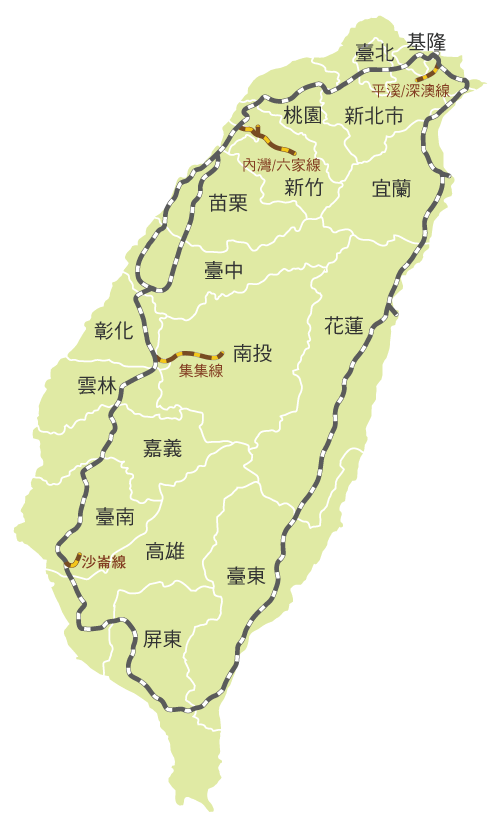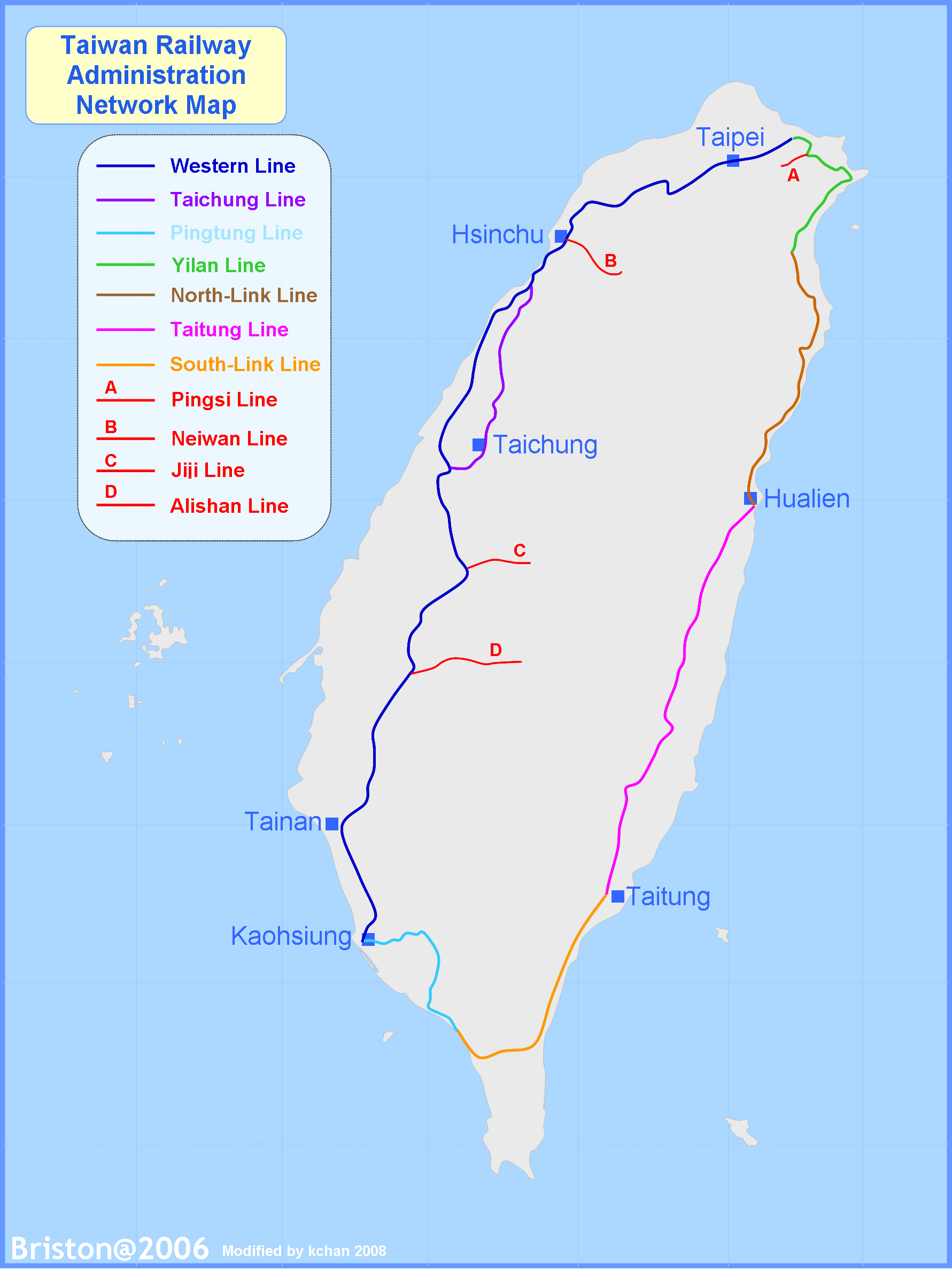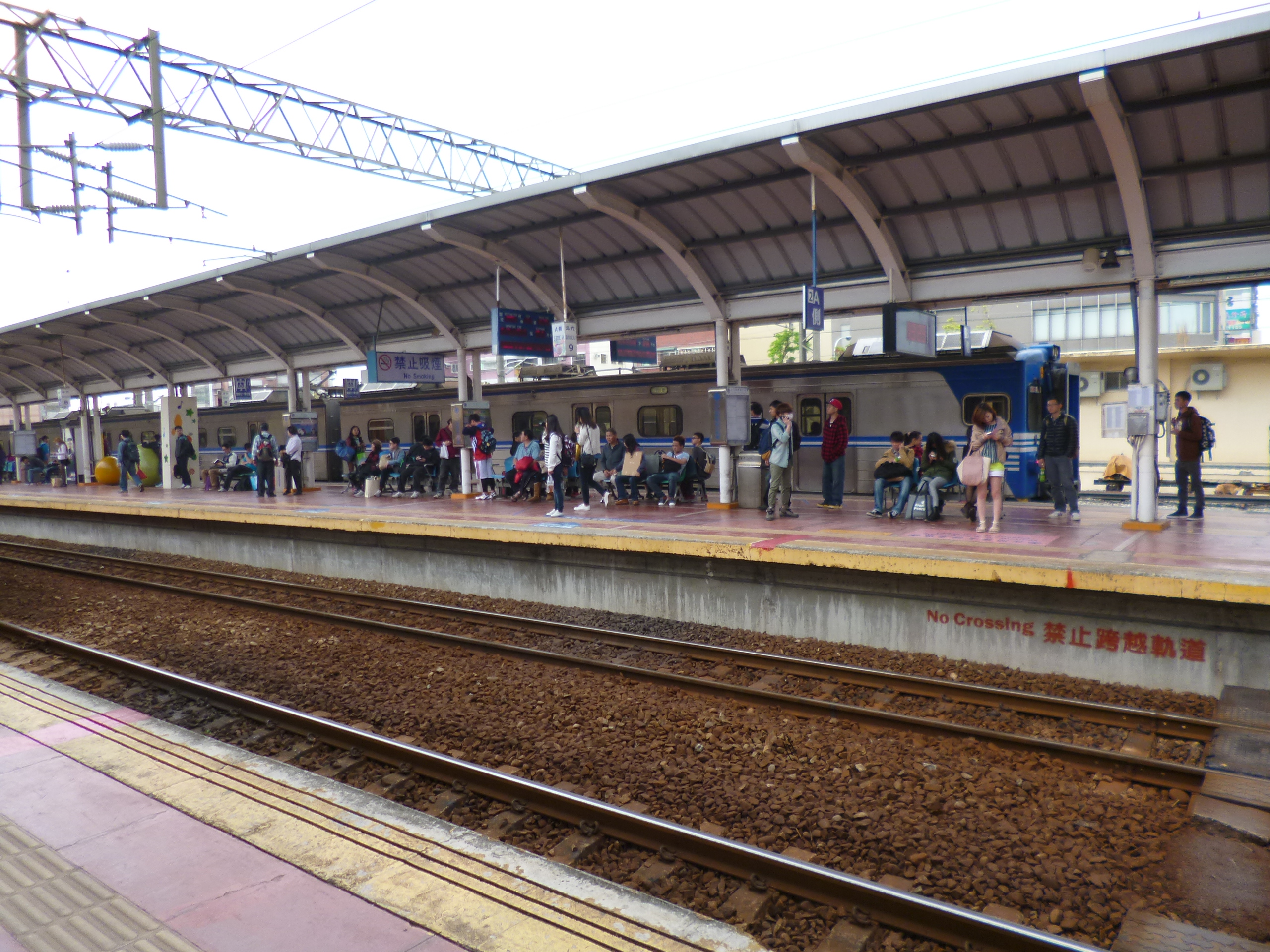|
Shiliu Railway Station
Shiliu () is a railway station on the Taiwan Railways Administration West Coast line located in Douliu City, Yunlin County, Taiwan. The station does not contain many passenger amenities. Overview This wooden station has two side platforms. The station originally had an island platform, but it was demolished after the station was converted to a depot. The station currently only serves local services and is considered a hikyō station. History *15 October 1905: Opened as Shiliuban-eki (石榴班驛). *19 September 1908: Due to lack of business, service ceased. *1941: Re-opened as Shiliuban Signal Field (石榴班信號場). *1945: Name changed to Shiliuban Switching Station (石榴班號誌站). *6 June 1950: Name changed to Shiliuban Station (石榴班車站). Upgraded to Class 3 station. *1 March 1955: Name changed to Shiliu Station (石榴站). *15 August 1990: Station is downgraded to a hikyō station. Management is now under Douliu Station. Around the station * Nationa ... [...More Info...] [...Related Items...] OR: [Wikipedia] [Google] [Baidu] |
Douliu
Douliu (Hokkien POJ: ''Táu-la̍k'') is a county-administered city and the county seat of Yunlin County, Taiwan. It is also the political and economic center of the county. Douliu City is served by National Highway No. 3. Name Its former name () came from a language of the Hoanya people, a tribe of the Taiwanese plains aborigines. History Empire of Japan In 1901, during Japanese rule, was one of twenty local administrative offices established. In 1909, part of Toroku was merged into , while the remainder was merged with . In 1920, was established and governed under , Tainan Prefecture. Toroku Town covered modern-day Douliu and Linnei Township. Republic of China On 25 December 1981, Douliu was upgraded from an urban township to county-administered city. Administrative divisions Xinyi, Siwei, Taiping, Zhonghe, Guangxing, Zengxi, Zengtung, Sanping, Mingde, Zengbei, Gongcheng, Zhongxiao, Renai, Bade, Gongzheng, Zhongguang, Lintou, Chenggong, Zengnan, Shekou, Longtan, Jiat ... [...More Info...] [...Related Items...] OR: [Wikipedia] [Google] [Baidu] |
Yunlin County
Yunlin County (Mandarin pinyin: ''Yúnlín Xiàn''; Taigi POJ: ''Hûn-lîm-koān''; Hakka PFS: ''Yùn-lìm-yen'') is a county in western Taiwan. Yunlin County borders the Taiwan Strait to the west, Nantou County to the east, Changhua County to the north at the Zhuoshui River, and Chiayi County to the south at the Beigang River. Yunlin is part of the Chianan Plain, a flat land known for its agriculture. Agricultural products of Yunlin County include pomelo, tea leaves, suan cai, papaya and muskmelon. Yunlin's rivers give it potential for hydroelectricity. Douliu is the largest and capital city of Yunlin. It is the only county on the main island of Taiwan where no city with the same name exists. North–South divide in Taiwan#Northern drifters (beipiao), Yunlin is one of the least developed counties on the West coast, and suffers from emigration. History Dutch Formosa During the Dutch Formosa era, ''Ponkan'' (modern-day Beigang, Yunlin, Beigang) was an important coastal castl ... [...More Info...] [...Related Items...] OR: [Wikipedia] [Google] [Baidu] |
Taiwan
Taiwan, officially the Republic of China (ROC), is a country in East Asia, at the junction of the East and South China Seas in the northwestern Pacific Ocean, with the People's Republic of China (PRC) to the northwest, Japan to the northeast, and the Philippines to the south. The territories controlled by the ROC consist of 168 islands, with a combined area of . The main island of Taiwan, also known as ''Formosa'', has an area of , with mountain ranges dominating the eastern two-thirds and plains in the western third, where its highly urbanised population is concentrated. The capital, Taipei, forms along with New Taipei City and Keelung the largest metropolitan area of Taiwan. Other major cities include Taoyuan, Taichung, Tainan, and Kaohsiung. With around 23.9 million inhabitants, Taiwan is among the most densely populated countries in the world. Taiwan has been settled for at least 25,000 years. Ancestors of Taiwanese indigenous peoples settled the isla ... [...More Info...] [...Related Items...] OR: [Wikipedia] [Google] [Baidu] |
Taiwan Railways Administration
Taiwan Railways Administration (TRA) is a railway operator in Taiwan. It is an agency of the Ministry of Transportation and Communications, responsible for managing, maintaining, and running conventional passenger and freight railway services on 1097 km of track in Taiwan. Since Taiwan is heavily urbanised with a high population density, railways have played an important part in domestic transportation since the late 19th century. Passenger traffic in 2018 was 231,267,955. The agency's headquarters are in Zhongzheng District, Taipei. Overview Railway services between Keelung and Hsinchu began in 1891 under China's Qing dynasty. Because the railway was completely rebuilt and substantially expanded under the operated by Formosa's Japanese colonial government (1895–1945), the network's Japanese influence and heritage persists. Similarities between the TRA and the Japan Railways (JR) companies can be noted in signal aspects, signage, track layout, fare controls, sta ... [...More Info...] [...Related Items...] OR: [Wikipedia] [Google] [Baidu] |
Railway Station
Rail transport (also known as train transport) is a means of transport that transfers passengers and goods on wheeled vehicles running on rails, which are incorporated in tracks. In contrast to road transport, where the vehicles run on a prepared flat surface, rail vehicles (rolling stock) are directionally guided by the tracks on which they run. Tracks usually consist of steel rails, installed on sleepers (ties) set in ballast, on which the rolling stock, usually fitted with metal wheels, moves. Other variations are also possible, such as "slab track", in which the rails are fastened to a concrete foundation resting on a prepared subsurface. Rolling stock in a rail transport system generally encounters lower frictional resistance than rubber-tyred road vehicles, so passenger and freight cars (carriages and wagons) can be coupled into longer trains. The operation is carried out by a railway company, providing transport between train stations or freight customer facilit ... [...More Info...] [...Related Items...] OR: [Wikipedia] [Google] [Baidu] |
West Coast Line (Taiwan)
Western Trunk line () is a railway line of the Taiwan Railways Administration in western Taiwan. It is by far the busiest line, having served over 171 million passengers in 2016. The total length of the line is 404.5 km. The line is an official classification of physical tracks and does not correspond to particular services. It is connected to Taichung line (''mountain line''; ) at Zhunan and Changhua. Many services turn inland to take the Taichung route, then reconnect back to the main line (West Coast line). Train schedules and departure boards mark either ''mountain'' or ''coastal'' () line to indicate the route taken. History The original railroad between Keelung and Twatutia was completed in 1891. The section between Twatutia and Hsinchu was finished in 1893. However, in the Japanese era, these sections were all rebuilt by the Government-General of Taiwan as part of its Taiwan Trunk Railway (, ''Jūkan Tetsudō'') project. The Taiwan Trunk Railway was completed in 1908 ... [...More Info...] [...Related Items...] OR: [Wikipedia] [Google] [Baidu] |
Side Platform
A side platform (also known as a marginal platform or a single-face platform) is a platform positioned to the side of one or more railway tracks or guideways at a railway station, tram stop, or transitway. A station having dual side platforms, one for each direction of travel, is the basic design used for double-track railway lines (as opposed to, for instance, the island platform where a single platform lies between the tracks). Side platforms may result in a wider overall footprint for the station compared with an island platform where a single width of platform can be shared by riders using either track. In some stations, the two side platforms are connected by a footbridge running above and over the tracks. While a pair of side platforms is often provided on a dual-track line, a single side platform is usually sufficient for a single-track line. Layout Where the station is close to a level crossing (grade crossing) the platforms may either be on the same side of the cross ... [...More Info...] [...Related Items...] OR: [Wikipedia] [Google] [Baidu] |
Island Platform
An island platform (also center platform, centre platform) is a station layout arrangement where a single platform is positioned between two tracks within a railway station, tram stop or transitway interchange. Island platforms are popular on twin-track routes due to pragmatic and cost reasons. They are also useful within larger stations where local and express services for the same direction of travel can be provided from opposite sides of the same platform thereby simplifying transfers between the two tracks. An alternative arrangement is to position side platforms on either side of the tracks. The historical use of island platforms depends greatly upon the location. In the United Kingdom the use of island platforms is relatively common when the railway line is in a cutting or raised on an embankment, as this makes it easier to provide access to the platform without walking across the tracks. Advantages and tradeoffs Island platforms are necessary for any station with many th ... [...More Info...] [...Related Items...] OR: [Wikipedia] [Google] [Baidu] |
Hikyō Station
A , or "secluded station," is the Japanese language name for railway stations that are little used and isolated. Photographers and rail fans visit the stations to take photos of historical stations and trains or photos of nature. The Japanese term ''hikyō eki'' was invented by Takanobu Ushiyama and his friends when he began a website in 1999 dedicated to these stations. He subsequently wrote two books: "Hikyo-eki e Iko!” (Let’s go to hikyo-eki!), published by Shogakukan Inc. in 2001 and “Motto Hikyo-eki e Iko!” (Let’s go to more hikyo-eki!), published in 2003. The term is now also used in other countries like Taiwan, especially among train fans. Summary Hikyō stations are generally located in areas that previously had a sizeable human population due to mountain climbing and related activities, but currently have very few inhabitants and houses. Because of this lack of population, the trains no longer make regular stops, and train and rail fans have adopted these ... [...More Info...] [...Related Items...] OR: [Wikipedia] [Google] [Baidu] |
Douliu Station
Douliu () is a railway station in Yunlin County, Taiwan served by Taiwan Railways. Yunlin HSR station can be accessed here by bus. Overview The station has two island platforms. Ticketing and customer service are located in the main concourse on the second floor, while tracks are located in front of and behind the station. The station has an accessibility elevator. History *1904-02-01: The station opened as Toroku-eki (斗六驛). *1940: After an earthquake, the station was closed for three months for reconstruction. *November 1958: The second-generation station (with reinforced concrete) was completed. *2006-11-03: The second-generation station was demolished. *2008-12-19: The current cross-platform station opened for service. Platform layout Around the station * Douliou City area * Huwei River * Yunlin River * Yunlin County Government * House of Citizen-Memorial Hall of Attendance * Douliu City Office * National Yunlin University of Science and Technology * TransW ... [...More Info...] [...Related Items...] OR: [Wikipedia] [Google] [Baidu] |
National Freeway 3
National Freeway 3 (), also known as Formosa Freeway (), is a freeway in Taiwan. It is the second north–south freeway in Taiwan, beginning in Keelung City at Jijin Interchange on the provincial highway 2 (Jijin Road) and ending in Linbian, Pingtung on the provincial highway 17. It is the longest freeway in Taiwan with a total length of . The freeway is also the only one in Taiwan to have a spur route, Freeway 3A. The highway has 58 interchanges, 15 junctions, 7 service areas and 3 rest areas en route. Aside from the 58 public interchanges, there are also some interchanges reserved for governmental usage. Route Description This freeway mostly serves as a bypass to major cities in Western Taiwan, traveling through suburban and rural areas. However, Freeway 3 is also the primary freeway in the counties of Nantou and Pingtung, as well as the first ever being built in these counties. Various expressways and east-west freeways link Freeway 3 with urban areas typically served by ... [...More Info...] [...Related Items...] OR: [Wikipedia] [Google] [Baidu] |
Soy Sauce Brewing Museum
The Soy Sauce Brewing Museum () is a museum in Douliu City, Yunlin County, Taiwan. Transportation The museum is accessible south east from Shiliu Station of Taiwan Railways. See also * List of museums in Taiwan This is a list of museums in Taiwan, including cultural centers and arts centres. Kaohsiung City * Chung Li-he Museum * Cijin Shell Museum * Fongshan Community Culture Museum * Former British Consulate at Takao * Hamasen Museum of Taiwan Rai ... References External links * Industry museums in Taiwan Museums in Yunlin County Soy products Food museums in Taiwan Soy sauces {{Taiwan-museum-stub ... [...More Info...] [...Related Items...] OR: [Wikipedia] [Google] [Baidu] |

.jpg)



